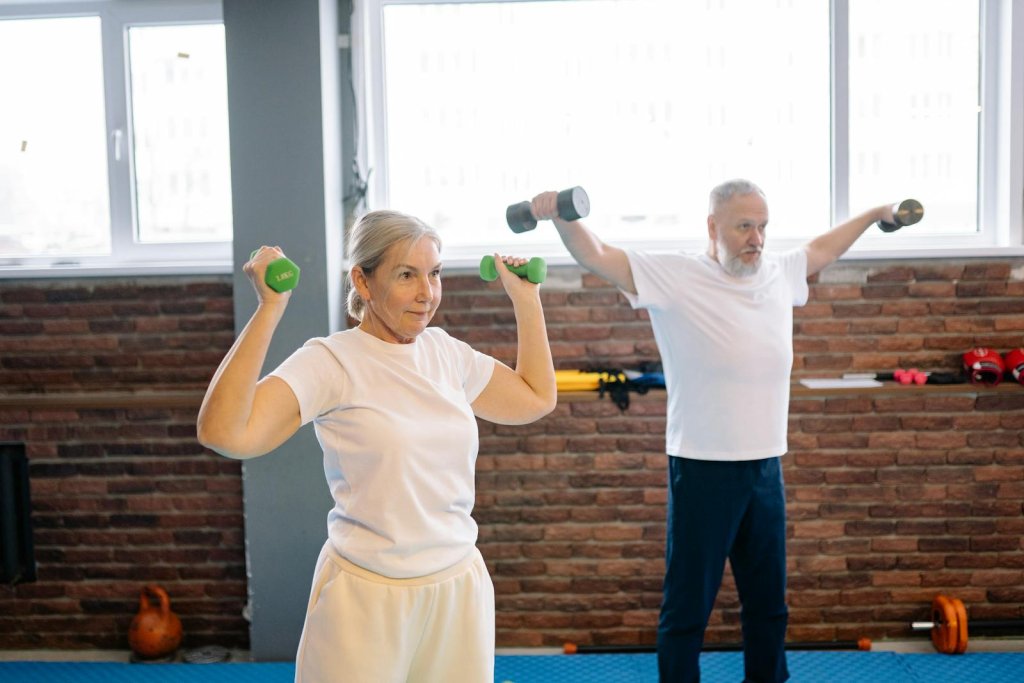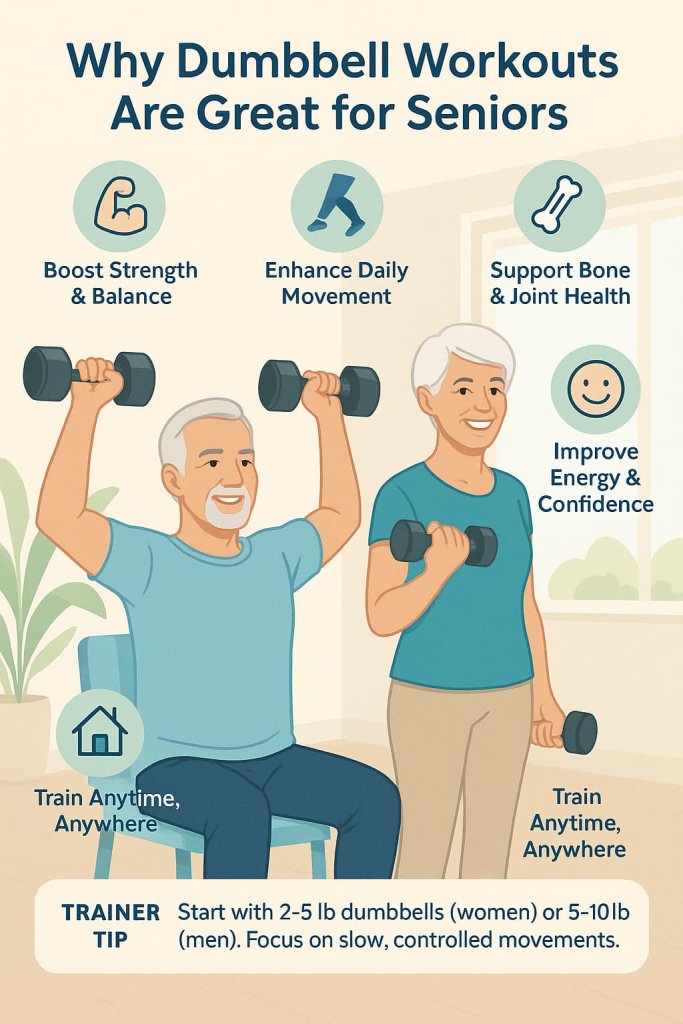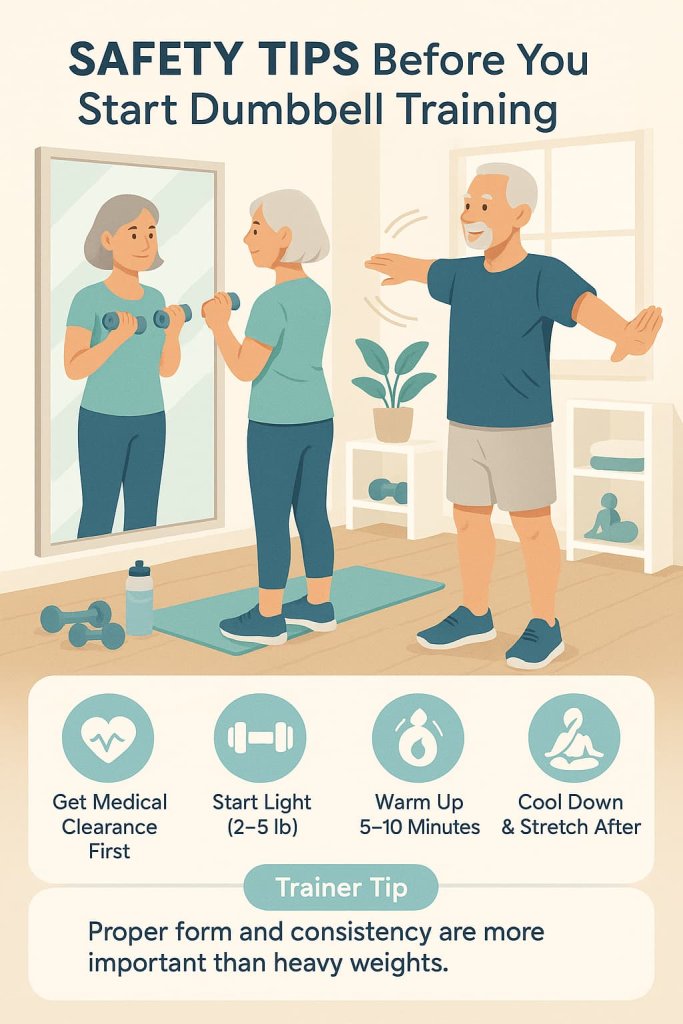Dumbbell exercises are one of the safest and most effective ways for seniors to stay strong, flexible, and independent. Using light weights regularly helps maintain muscle tone, improve balance, and reduce the risk of falls — all essential for healthy aging. Strength training with dumbbells also supports bone density, joint health, and overall mobility, allowing older adults to perform daily tasks with greater ease and confidence.

According to the Mayo Clinic (2025), strength training twice a week can slow muscle loss that naturally occurs with age, while the CDC’s “Growing Stronger” guide confirms that free-weight training improves both bone strength and balance in seniors.
Below is a complete, step-by-step guide to the best dumbbell exercises for seniors — all easy to modify, beginner-friendly, and designed to keep you moving safely.
Why Dumbbell Workouts Are Great for Seniors
- Boost strength and balance – Supports posture and reduces fall risk.
- Enhance daily mobility – Makes climbing stairs, lifting objects, or standing up easier.
- Support bone and joint health – Weight-bearing resistance helps prevent osteoporosis.

- Improve mental health – Regular movement boosts energy, confidence, and mood.
- Low-cost and flexible – Can be done at home with minimal space and equipment.
Trainer Tip: Start with 2–5 lb dumbbells (women) or 5–10 lb (men). Focus on slow, controlled movements rather than heavy loads.
Safety Tips Before You Start Dumbbell Training
- Before beginning, get medical clearance if you have health concerns.
- Start light (2–5 lb dumbbells) and focus on slow, controlled movements.

- Warm up for 5–10 minutes and maintain good posture throughout.
- Stop immediately if you feel pain, dizziness, or discomfort.
- Cool down and stretch after each session.
Trainer Tip: Proper form and consistency are more important than heavy weights.
15 Best Dumbbell Exercises for Seniors
These 15 dumbbell exercises are simple, effective, and safe for seniors — helping you build strength, balance, and confidence at any age.
Stay consistent, focus on form, and enjoy stronger, more active living every day.
1. Seated Dumbbell Shoulder Press
Why it works:
This foundational upper-body move strengthens the shoulders and arms, helping seniors maintain independence in daily tasks such as reaching overhead, carrying groceries, or lifting light objects. It also improves shoulder stability and posture, which decline naturally with age.
Muscles worked: Deltoids, triceps, and upper back.
How to do it:
- Sit upright on a sturdy chair with feet flat on the floor.
- Hold a dumbbell in each hand at shoulder height, palms facing forward.
- Engage your core and press the weights upward until your arms are fully extended overhead.
- Pause briefly, then lower the weights slowly back to the starting position.
Trainer Tip: Keep your core engaged and avoid arching your lower back. Use light weights and focus on controlled movement rather than speed.
2. Dumbbell Bicep Curl
Why it works:
Improves strength for lifting and carrying everyday items. Strengthening the biceps helps stabilize the elbows and reduces arm fatigue in routine tasks.
Muscles worked: Biceps and forearms.
How to do it:
- Stand or sit upright with arms relaxed at your sides.
- Hold dumbbells with palms facing forward.
- Slowly curl both weights toward your shoulders.
- Pause briefly at the top, then lower the weights with control.
Trainer Tip: Keep elbows close to your torso and avoid swinging the weights.
3. Seated Dumbbell Chest Press
Why it works:
Builds upper-body pushing strength for tasks like pushing doors, carrying groceries, or getting up from a chair. It also strengthens the chest and arms while promoting better posture.
Muscles worked: Pectorals, deltoids, triceps.
How to do it:
- Sit tall on a chair or bench.
- Hold dumbbells at chest level, elbows bent.
- Press the weights forward and upward until arms are extended.
- Slowly return to the starting position.
Trainer Tip: Exhale as you press up and inhale as you lower.
4. Dumbbell Front Raise
Why it works:
Enhances shoulder mobility and helps maintain good posture by strengthening the front deltoids and stabilizing the upper body.
Muscles worked: Front deltoids, upper chest.
How to do it:
- Stand tall, holding dumbbells in front of thighs.
- Lift both arms straight up to shoulder height, keeping a slight bend in your elbows.
- Lower slowly back to start.
Trainer Tip: Avoid swinging — lift and lower under full control.
5. Standing Lateral Raise
Why it works:
Strengthens the shoulders and improves balance and stability, key factors in fall prevention.
Muscles worked: Lateral deltoids.
How to do it:
- Hold dumbbells at sides with palms facing inward.
- Raise both arms out to the sides until level with shoulders.
- Lower slowly and repeat.
Trainer Tip: Use light weights and keep movements smooth — no shrugging or jerking.
6. Dumbbell Squat to Chair
Why it works:
Strengthens lower-body muscles and mimics sitting and standing motions — vital for maintaining independence.
Muscles worked: Quadriceps, glutes, hamstrings.
How to do it:
- Stand in front of a sturdy chair, holding dumbbells at your sides.
- Slowly lower your hips as if sitting down, lightly touching the chair.
- Push through your heels to return to standing.
Trainer Tip: Keep your knees aligned with toes and avoid collapsing inward.
7. Dumbbell Deadlift (Modified)
Why it works:
Improves hip strength, posture, and spinal alignment while strengthening muscles that support everyday lifting and bending.
Muscles worked: Hamstrings, glutes, lower back.
How to do it:
- Stand tall with dumbbells in front of thighs.
- Hinge at the hips, lowering weights to mid-shin while keeping your back straight.
- Engage your glutes and return to standing.
Trainer Tip: Focus on hinging at the hips, not rounding your back.
8. Seated Dumbbell Row
Why it works:
Strengthens the upper back and counteracts the effects of slouching, improving posture and shoulder health.
Muscles worked: Rhomboids, lats, biceps.
How to do it:
- Sit forward on a sturdy chair with arms extended holding dumbbells.
- Pull the weights toward your waist, squeezing your shoulder blades together.
- Lower slowly to start.
Trainer Tip: Keep your spine neutral and avoid rounding your shoulders.
9. Dumbbell Side Bend
Why it works:
Strengthens the obliques and supports spinal mobility, helping with twisting and bending movements.
Muscles worked: Obliques, lower back.
How to do it:
- Hold one dumbbell in your right hand, other hand on your hip.
- Lean slowly to the right side, lowering the dumbbell toward your knee.
- Return upright and repeat on the opposite side.
Trainer Tip: Move in a controlled manner — avoid twisting or jerking.
10. Dumbbell Step-Up
Why it works:
Improves leg strength, coordination, and balance, which are essential for stair climbing and walking stability.
Muscles worked: Quads, glutes, calves.
How to do it:
- Hold dumbbells at your sides.
- Step one foot onto a low step or sturdy platform.
- Press through your heel to stand tall, then step down carefully.
- Alternate legs.
Trainer Tip: Use a stable surface and perform slowly for safety.
11. Dumbbell Calf Raise
Why it works:
Strengthens calf muscles for walking and balance, improving stability during movement.
Muscles worked: Gastrocnemius, soleus.
How to do it:
- Stand upright with dumbbells at your sides.
- Rise onto the balls of your feet.
- Pause briefly, then lower slowly.
Trainer Tip: Hold onto a wall or chair for balance if needed.
12. Seated Dumbbell Overhead Triceps Extension
Why it works:
Targets the back of the arms, helping tone and strengthen muscles often underused in daily life.
Muscles worked: Triceps.
How to do it:
- Sit tall, holding one dumbbell with both hands above your head.
- Bend your elbows to lower the weight behind your head.
- Extend your arms fully and repeat.
Trainer Tip: Keep elbows close to ears and move slowly to protect your shoulders.
13. Dumbbell Toe Touch
Why it works:
Improves flexibility, core control, and coordination while strengthening the abdominals and lower back.
Muscles worked: Abs, lower back, hamstrings.
How to do it:
- Sit on a mat, holding a light dumbbell.
- Extend your legs forward and lift the weight toward your toes.
- Lower the dumbbell back slowly to starting position.
Trainer Tip: Avoid rounding your lower back — move through your hips and core.
14. Dumbbell March
Why it works:
Enhances coordination and strengthens the hip flexors and core, which are crucial for stable walking and balance.
Muscles worked: Hip flexors, abs, legs.
How to do it:
- Stand tall, holding dumbbells at your sides.
- March in place, lifting each knee to hip level.
- Continue for 30–60 seconds.
Trainer Tip: Focus on posture and steady rhythm rather than speed.
15. Dumbbell Farmer’s Carry
Why it works:
Builds grip strength, shoulder stability, and full-body endurance — essential for daily tasks like carrying groceries or laundry.
Muscles worked: Forearms, shoulders, core, legs.
How to do it:
- Hold dumbbells at your sides and stand tall.
- Walk 20–30 steps while maintaining upright posture.
- Rest briefly and repeat.
Trainer Tip: Keep your shoulders back and core tight — this exercise is excellent for improving functional strength and balance.
Sample Weekly Dumbbell Routine for Seniors
| Day | Workout Focus | Example Exercises |
|---|---|---|
| Monday | Upper Body | Shoulder Press, Bicep Curl, Seated Row |
| Wednesday | Lower Body | Squats, Step-Ups, Deadlifts |
| Friday | Full Body + Core | Farmer’s Carry, Side Bend, March |
| Saturday | Active Recovery | Light walk or stretching |
Common Mistakes to Avoid When Lifting Weights
- Avoid lifting too heavy, rushing reps, or holding your breath.
- Never skip warm-ups, cool-downs, or rest days.
- Keep your back straight and core tight to protect your spine.
- Move with control — not momentum.
Trainer Tip: Good technique prevents injury and delivers better long-term results.
FAQs About Dumbbell Training for Seniors
1. Can seniors safely lift weights?
Yes. Research shows strength training is safe and beneficial at any age when performed with proper form and moderate intensity.
2. How often should older adults lift weights?
The CDC recommends 2–3 strength sessions per week with at least one rest day in between.
3. What weight should seniors start with?
Start light — 2 to 5 lbs — and increase gradually as strength improves.
4. Are dumbbells better than resistance bands?
Both are great. Dumbbells provide more stability and allow easy progression, while bands are excellent for joint-friendly resistance.
5. Can strength training improve balance and prevent falls?
Yes. Regular dumbbell workouts strengthen legs and core muscles that help maintain stability.
6. What if I have arthritis or joint pain?
Opt for lighter weights, higher reps, and controlled movements. Always consult a physical therapist or doctor for guidance.
7. Do I need a gym to start?
No. All 15 exercises can be done safely at home with minimal space and a sturdy chair.
Conclusion
Staying active as you age doesn’t require a gym — just a pair of dumbbells and consistency. These 15 exercises help build strength, improve balance, and keep you independent for years to come. Start small, stay patient, and enjoy the progress.
Take the first step today — your stronger, healthier future is in your hands.
References
- CDC — Physical Activity Guidelines for Older Adults (2023 update): https://www.cdc.gov/physical-activity-basics/guidelines/older-adults.html
- NIA (NIH) — Exercise & Physical Activity Hub: https://www.nia.nih.gov/health/exercise-and-physical-activity
- NIA — Get Fit for Life (May 2024 booklet, PDF): https://order.nia.nih.gov/sites/default/files/2024-05/get-fit-life-book.pdf
- WHO — Guidelines on Physical Activity & Sedentary Behaviour (2020): https://www.who.int/publications/i/item/9789240015128
- NSCA — Position Statement: Resistance Training for Older Adults: https://www.nsca.com/about-us/position-statements/resistance-training-for-older-adults/
- Systematic Review & Meta-analysis (2023) — Resistance training benefits in adults ≥60: https://pubmed.ncbi.nlm.nih.gov/35968662/
- CDC — Growing Stronger: Strength Training for Older Adults (Guide, PDF): https://www.cdc.gov/physicalactivity/downloads/growing_stronger.pdf
- Mayo Clinic Press — Benefits of Resistance Training as You Age (Sept 27, 2024): https://mcpress.mayoclinic.org/healthy-aging/the-many-benefits-of-resistance-training-as-you-age/
